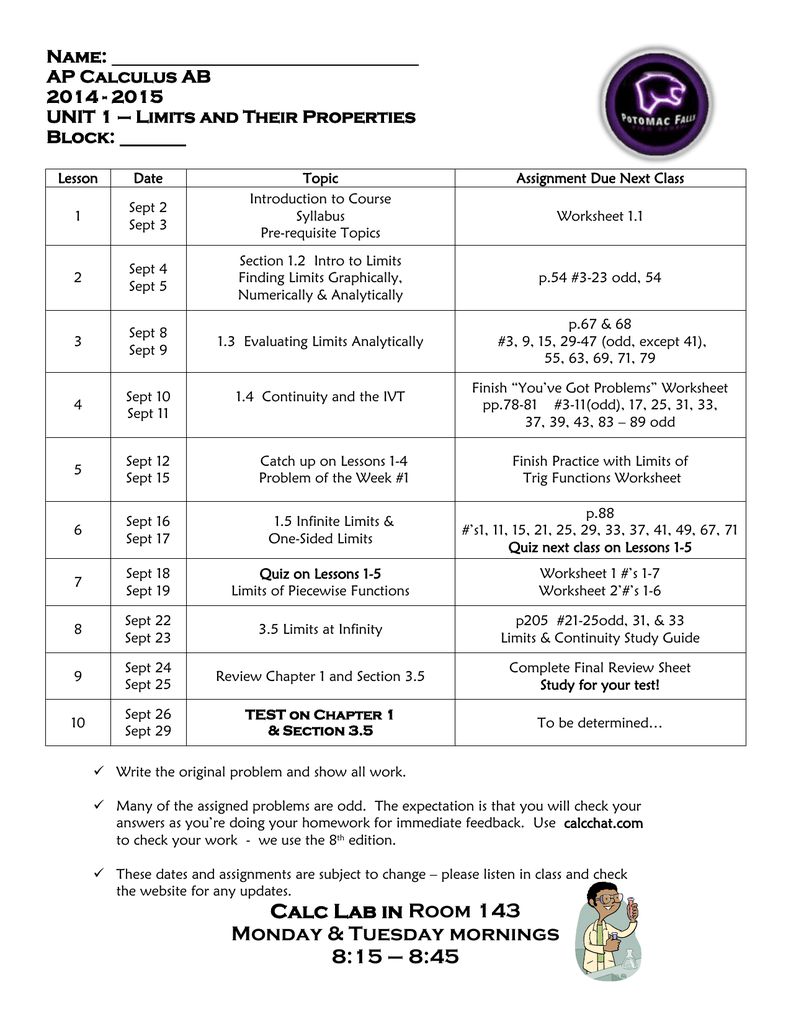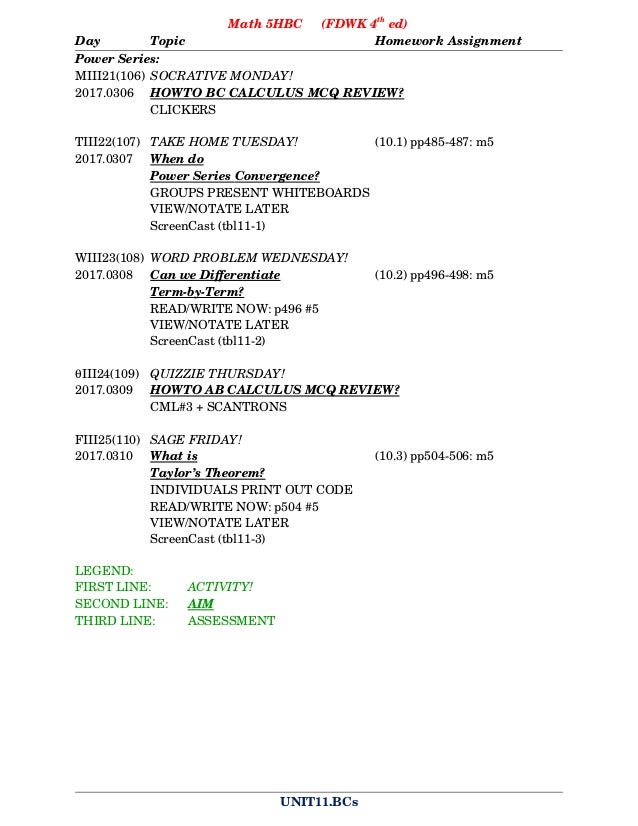Unit 1 - Limits and Continuity
| ||||||||||||||||||||||||||||||||||||||||||||||||||||||||||||||||||||||||||||||||||||||||||||||||||||||||||||||||||||||||||||||||||||||||||||||||
________________________________________________________________________________________________
ENDURING UNDERSTANDING
Calculus: Home List of Lessons Teacher Resources UNIT 1 - Limits. 1.1 Limits Graphically. 1.2 Limits Analytically. Unit 1 - Chapters 1 & 2 - limits & continuity The New Changes to AP Calculus - effective 2016 - 2017. Unit 1 Limits, Continuity & Derivative Concepts In this introductory unit, students will explore the foundational aspects of calculus by learning the elementary concept of limits and discovering how limits relate to the continuity of functions. Unit Guides 26 Using the Unit Guides 29 UNIT 1: Limits and Continuity 51 UNIT 2: Differentiation: Definition and Fundamental Properties 67 UNIT 3: Differentiation: Composite, Implicit, and Inverse Functions 79 UNIT 4: Contextual Applications of Differentiation 91 UNIT 5: Analytical Applications of Differentiation 109 UNIT 6: Integration.
LIM-1 Reasoning with definitions, theorems, and properties can be used to justify claims about limits.
______________________________________________________________________________________________
Topic Name & Learning Objective: | Essential Knowledge |
| 1.1 Introducing Calculus: Can change occur in an instant? LEARNING OBJECTIVE CHA-1.A Interpret the rate of change at an instant in terms of average rates of change over intervals containing that instant. | CHA-1.A.1 Calculus uses limits to understand and model dynamic change. |
| CHA-1.A.2 Because an average rate of change divides the change in one variable by the change in another, the average rate of change is undefined at a point where the change in the independent variable would be zero. | |
| CHA-1.A.3 The limit concept allows us to define instantaneous rate of change in terms of average rates of change. |
______________________________________________________________________________________________

| 1.2 Defining Limits Using Limit Notation LEARNING OBJECTIVES LIM-1.A Represent limits analytically using correct notation. IM-1.B Interpret limits expressed in analytic notation. | LIM-1.A.1 Given a function f, the limit of f (x) as x approaches c is a real number R if f (x) can be made arbitrarily close to R by taking x sufficiently close to c (but not equal to c). If the limit exists and is a real number, then |
| LIM-1.B.1 A limit can be expressed in multiple ways, including graphically, numerically, and analytically. |
Blog Posts
Deltas and Epsilons Why this topic is not tested on the AP Calculus Exams.
______________________________________________________________________________________________
| 1.3 Estimating Limit Values from Graphs LEARNING OBJECTIVE LIM-1.C Estimate limits of functions. | LIM-1.C.1 The concept of a limit includes one sided limits. |
| LIM-1.C.2 Graphical information about a function can be used to estimate limits. | |
| LIM-1.C.3 Because of issues of scale, graphical representations of functions may miss important function behavior. | |
| LIM-1.C.4 A limit might not exist for some functions at particular values of x. Some ways that the limit might not exist are if the function is unbounded, if the function is oscillating near this value, or if the limit from the left does not equal the limit from the right. |
Blog Posts
Finding Limits How to…
______________________________________________________________________________________________
| 1.4 Estimating Limit Values from Tables LEARNING OBJECTIVE LIM-1.C Estimate limits of functions. | LIM-1.C.5 Numerical information can be used to estimate limits. |
Blog Posts
Finding Limits How to…
Unit 1 Limitsap Calculus Calculator
______________________________________________________________________________________________
| 1.5 Determining Limits Using Algebraic Properties of Limits LEARNING OBJECTIVE LIM-1.D Determine the limits of functions using limit theorems. | LIM-1.D.1 One-sided limits can be determined analytically or graphically. |
| LIM-1.D.2 Limits of sums, differences, products, quotients, and composite functions can be found using limit theorems. |
Finding Limits How to…
______________________________________________________________________________________________
| 1.6 Determining Limits Using Algebraic Manipulation LEARNING OBJECTIVE LIM-1.E Determine the limits of functions using equivalent expressions for the function or the squeeze theorem | LIM-1.E.1 It may be necessary or helpful to rearrange expressions into equivalent forms before evaluating limits. |
Blog Posts
Finding Limits How to…
______________________________________________________________________________________________
| 1.7 Selecting Procedures for Determining Limits | None |
Blog Posts
Finding Limits How to…
______________________________________________________________________________________________
| 1.8 Determining Limits Using the Squeeze Theorem LEARNING OBJECTIVE LIM-1.E Determine the limits of functions using equivalent expressions for the function or the squeeze theorem. | ESSENTIAL KNOWLEDGE LIM-1.E.2 The limit of a function may be found by using the squeeze theorem. |
Blog Posts
none
______________________________________________________________________________________________

| 1.9 Connecting Multiple Representations of Limits | None |
Blog Posts
Finding Limits How to…
______________________________________________________________________________________________
ENDURING UNDERSTANDING
LIM-2 Reasoning with definitions, theorems, and properties can be used to justify claims about continuity.
______________________________________________________________________________________________
| 1.10 Exploring Types of Discontinuities LEARNING OBJECTIVE LIM-2.A Justify conclusions about continuity at a point using the definition. | LIM-2.A.1 Types of discontinuities include removable discontinuities, jump discontinuities, and discontinuities due to vertical asymptotes. |
Blog Posts
Continuity Should continuity come before limits?
Continuity The definition of continuity.
Continuous Fun A fuller discussion of continuity and its definition
Fun with Continuity Defined everywhere and continuous nowhere. Continuous only at a single point.
Right Answer – Wrong Question Continuity or continuity “on its domain”?
______________________________________________________________________________________________
| 1.11 Defining Continuity at a Point LEARNING OBJECTIVE LIM-2.A Justify conclusions about continuity at a point using the definition. | LIM-2.A.2 A function f is continuous at x = c provided that f(c) exists, exists, and |
Blog Posts
Continuity The definition of continuity.
Continuous Fun A fuller discussion of continuity and its definition
Continuity The definition of continuity.
Continuous Fun A fuller discussion of continuity and its definition
______________________________________________________________________________________________
| 1.12 Confirming Continuity on an Interval LEARNING OBJECTIVE LIM-2.B Determine intervals over which a function is continuous. | LIM-2.B.1 A function is continuous on an interval if the function is continuous at each point in the interval. |
| LIM-2.B.2 Polynomial, rational, power, exponential, logarithmic, and trigonometric functions are continuous on all points in their domains. |
Blog Posts
Continuity The definition of continuity.
Continuous Fun A fuller discussion of continuity and its definition
Continuity The definition of continuity.
Continuous Fun A fuller discussion of continuity and its definition
______________________________________________________________________________________________
| 1.13 Removing Discontinuities LEARNING OBJECTIVE LIM-2.C Determine values of x or solve for parameters that make discontinuous functions continuous, if possible. | LIM-2.C.1 If the limit of a function exists at a discontinuity in its graph, then it is possible to remove the discontinuity by defining or redefining the value of the function at that point, so it equals the value of the limit of the function as x approaches that point. |
| LIM-2.C.2 In order for a piecewise-defined function to be continuous at a boundary to the partition of its domain, the value of the expression defining the function on one side of the boundary must equal the value of the expression defining the other side of the boundary, as well as the value of the function at the boundary. |
Blog Posts
Continuity The definition of continuity.
Continuous Fun A fuller discussion of continuity and its definition
Continuity The definition of continuity.
Continuous Fun A fuller discussion of continuity and its definition
______________________________________________________________________________________________
| 1.14 Connecting Infinite Limits and Vertical Asymptotes LEARNING OBJECTIVE LIM-2.D Interpret the behavior of functions using limits involving infinity. | LIM-2.D.1 The concept of a limit can be extended to include infinite limits. |
| LIM-2.D.2 Asymptotic and unbounded behavior of functions can be described and explained using limits. |
Blog Posts
Right Answer – Wrong Question Is a function continuous even if it has a vertical asymptote?
Asymptotes The graphical manifestation of certain limit
How to Tell Your Asymptote from a Hole in the Graph From the technology series. Showing holes and asymptotes on a graphing calculator.
______________________________________________________________________________________________
| 1.15 Connecting Limits at Infinity and Horizontal Asymptotes LEARNING OBJECTIVE LIM-2.D Interpret the behavior of functions using limits involving infinity. | LIM-2.D.3 The concept of a limit can be extended to include limits at infinity. |
| LIM-2.D.4 Limits at infinity describe end behavior. | |
| LIM-2.D.5 Relative magnitudes of functions and their rates of change can be compared using limits. |

Blog Posts
Asymptotes The graphical manifestation of certain limits
Far Out A fun limit, but best saved until after students can find maximum values and points of inflection.
______________________________________________________________________________________________
ENDURING UNDERSTANDING
FUN-1 Existence theorems allow us to draw conclusions about a function’s behavior on an interval without precisely locating that behavior.
______________________________________________________________________________________________
Ap Calculus Review Unit 1 Limits And Continuity

| 1.16 Working with the Intermediate Value Theorem LEARNING OBJECTIVE FUN-1.A Explain the behavior of a function on an interval using the Intermediate Value Theorem. | FUN-1.A .1 If f is a continuous function on the closed interval [a, b] and d is a number between f (a) and f (b), then the Intermediate Value Theorem guarantees that there is at least one number c between a and b, such that f(c) = d. |
Blog Posts
Theorems The Intermediate Value Theorem (IVT) and suggestions on teaching theorems
Intermediate Weather Using the I
Then There Is This on Existence Theorems
______________________________________________________________________________________________
| Exclusion Statement | EXCLUSION STATEMENT The epsilon-delta definition of a limit is not assessed on the AP Calculus AB or BC Exam. However, teachers may include this topic in the course if time permits. |
Blog Posts
Deltas and Epsilons Why this topic is not tested on the AP Calculus Exams.
______________________________________________________________________________________________
